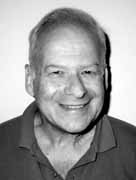Person: Lumer, Günter

Günter Lumer was born in Germany but his Jewish family were forced to flee from the Nazis in 1933, eventually going to Uruguay where Günter was educated. He spent half his career in the United States and half in Belgium. He was a creative and prolific mathematician whose works have great influence on the research community in functional analysis and evolution equations.
Mathematical Profile (Excerpt):
- In France, Günter Lumer was known as Guy Lumer and there he began his education.
- The American Zone in Germany recorded the German Jew Hans Lumer of Frankfurt an Main as one of those persecuted.
- Lumer entered the University of Uruguay in Montevideo to study electrical engineering.
- Lumer, who studied mathematics as part of the electrical engineering course, attended lectures by Halmos who tried to persuade him that mathematics and not electrical engineering was the subject for him.
- Lumer made a lot of small mistakes, kept correcting them, and converged to the truth by successive approximations.
- Lumer's stuff would come out structurally organised but chaotic in its details ...
- Lumer was not the only student that Halmos encouraged to undertake research in mathematics while at the University of Montevideo.
- The other student was Juan Jorge Schäffer who, like Lumer was studying engineering and taking mathematics courses given by Halmos.
- Halmos, Lumer and Schäffer wrote the joint paper Square roots of operators which they submitted to the American Mathematical Society on 4 April 1952.
- Despite these excellent mathematics papers, Lumer was still studying electrical engineering at the University of Uruguay and he graduated in 1957 with an engineering degree.
- After his close working with Halmos, it is not surprising that Lumer went to the University of Chicago where Halmos was working.
- At Chicago, Lumer's doctoral studies were supervised by Irving Kaplansky and he submitted his thesis Numerical Range and States in the Theory of Banach Space Operators in August 1959.
- We should make it clear that Lumer had several papers published while he was an undergraduate in Montevideo in addition to those with Halmos, and also while he was in Chicago, such as: Fine structure and continuity of spectra in Banach algebras (1954), Sets with connected spherical section (Portuguese) (1955), Polygons inscriptible in convex curves (Spanish) (1956), (with A Jones) A note on radical rings (Spanish) (1956), The range of the exponential function (1957), Commutators in Banach algebras (Spanish) (1957), (with Marvin Rosenblum) Linear operator equations (1959).
- Lumer did not return to Uruguay but remained in the United States where he was appointed to a one-year position at the University of California at Los Angeles for 1959-60.
- After these two one-year appointments, Lumer was appointed to the University of Washington where he worked from 1961 to 1974.
- It was in 1961 that Lumer published the result which today bears his name, the Lumer-Phillips theorem, which gives necessary and sufficient conditions on an operator to generate a strongly continuous semigroup of contractions on a general Banach space.
- The result appears in the paper Dissipative operators in a Banach space published in the Pacific Journal of Mathematics by Lumer and Ralph Saul Phillips (1913-1998).
- Ralph Phillips was on the staff at the University of California at Los Angeles in the year that Lumer spent there and moved to Stanford University in 1960, spending a second year with Lumer.
- In 1962 Lumer attended, by invitation, the functional analysis conference in Oberwolfach, the research centre in the Black Forest in Germany.
- In the academic year 1969/70 Günter Lumer together with Irving Glicksberg organised a Research Seminar on function algebras at their home University, the University of Washington in Seattle.
- In 1973 Lumer moved from the United States to take up a permanent position in Europe at the University of Mons-Hainaut in Mons, Wallonia, Belgium.
- In 1976, supported by the Belgium National Science Foundation, Günter founded a contact group with the goal of organising research and exchange meetings in the fields of Partial Differential Equations and Functional Analysis.
- From the 1990s on, building on the success of this group, Günter became a driving force and leading contributor to several large-scale projects sponsored by the European Community.
- These activities, combined with Günter's relentless energy and love for mathematics, were at the origin of the breath-taking development of the field of evolution equations and the theory of operator semigroups after the pioneering book of Hille and Phillips from 1957.
- Those seminars covered a broad range of topics in analysis and were a reflection of the true spirit of Günter Lumer, who always enjoyed bringing together and working with a wide range of mathematicians and scientists.
- In 1997 a serious hip joint operation reduced Lumer's mobility but he was able to continue with most of his mathematical activities.
- The Lumer Lectures were set up by the European Cooperation in Science and Technology Action CA18232, Mathematical Models for Interacting Dynamics on Networks.
- is named after Gunter Lumer, a great mathematician with extensive achievements and a deep curiosity for applied functional analysis and operator theory, and is a joint scientific activity of all Action's Working Groups.
Born 29 May 1929, Frankfurt an Main, Germany. Died 24 June 2005, Brussels, Belgium.
View full biography at [MacTutor](https://mathshistory.st-andrews.ac.uk/Biographies/Lumer/
Thank you to the contributors under CC BY-SA 4.0! 

- Github:
-

- non-Github:
- @J-J-O'Connor
- @E-F-Robertson
References
Adapted from other CC BY-SA 4.0 Sources:
- O’Connor, John J; Robertson, Edmund F: MacTutor History of Mathematics Archive
